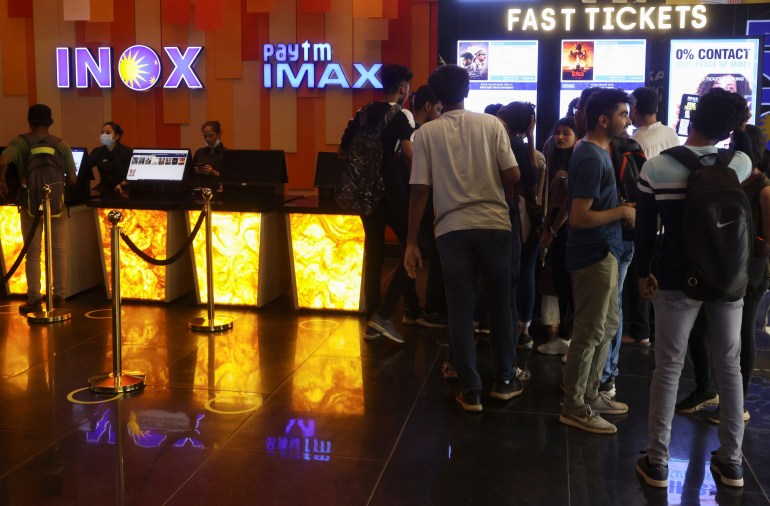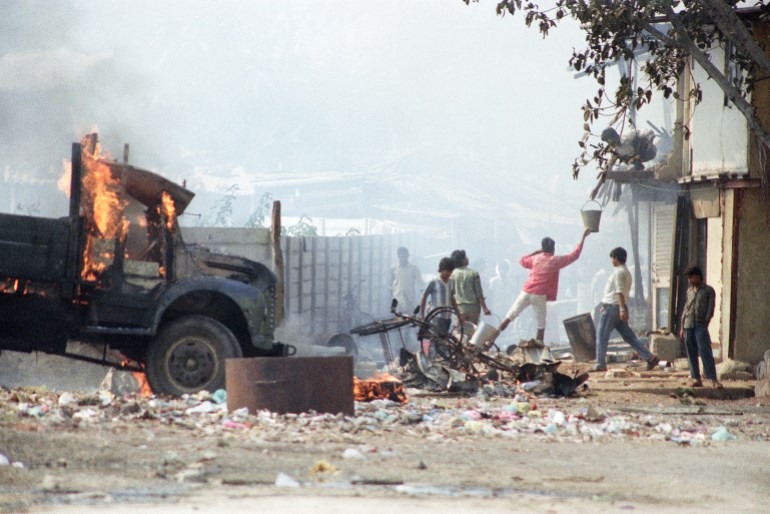Yavatmal has been in the grip of agrarian distress so deep that more than 5,800 farmers have taken their own lives here in the last two decades, according to data provided by the local divisional collectorate.
But these trucks haven’t been carrying any relief for distressed farmers. Instead, with a photo of the Hindu god Ram on posters stuck on their sides, the trucks have been foraying deep inside the district, exhorting farmers to donate grains.
The grains are headed to Ayodhya to feed hundreds of thousands of devotees visiting the city where Prime Minister Narendra Modi will consecrate a temple to Ram on January 22, over three decades after a mob led by Hindu nationalists tore down a mosque that stood on the spot.
The trucks are being operated by the Vishwa Hindu Parishad (VHP), a part of the Hindu nationalist network Sangh Parivar led by the Rashtriya Swayamsevak Sangh (RSS) that includes Modi’s Bharatiya Janata Party (BJP).
At Yavatmal’s Samvidhan Chowk, workers hurriedly load a large container truck with sacks of grains. “We have managed to fill three container trucks with these donations, and this is the fourth one,” says VHP Vidarbha Prant President Raju Niwal. The idea, VHP volunteers on the spot say, is to mobilise farmers and make them “feel involved” in the celebrations.
It’s a sentiment that the Modi government and its ideological allies have successfully managed to evoke across the country.
For over seven decades, the movement to build the Ram temple in Ayodhya, at the spot where he is believed to have been born according to Hindu scriptures, had been shrouded in violence and bitter contestation. Close to 2,500 people (PDF), according to a research paper by the Institute of Peace and Conflict Studies, were killed during the violence that broke out around the BJP-led agitation demanding a Ram temple in the early 1990s.
But as Modi gets set to inaugurate the Ram temple, the country has been flooded by popular culture acts and symbols that ignore that troubled past, giving the Ram temple movement a benign image, and creating a lasting legacy for Modi among Hindus, say analysts.

Pop songs and popcorn
From social media timelines to schools, the temple’s inauguration is everywhere. Music platforms are filled with a glut of new songs exhorting citizens to celebrate the occasion, insisting that Ram was “coming back”. New TV shows have come up around Ram’s life. Reality TV shows have dedicated entire episodes to songs hailing Ram, with a makeshift temple built in the studio. News television channel vehicles are sporting huge Ram stickers, while news studios feature large cutouts of Ram as the backdrop for news debates. India’s largest domestic airline, Indigo, got its cabin crew to dress up as Ram, wife Sita and brother Lakshman, in its inaugural flight to Ayodhya from Ahmedabad.
On Friday, PVR Cinemas, one of India’s largest cinema chains, announced that they were, in association with a top Hindi news channel Aaj Tak, going to broadcast live visuals of the temple’s inauguration ceremony in cinema halls across the country, with “a complimentary popcorn combo” for attendees.
On WhatsApp and Instagram, reels and videos are honouring the temple’s inauguration with vivid imagery – one image, viral across platforms, shows Modi, towering over Ram, and walking him into the temple.
Modi has approved most of this – an analysis of his Twitter timeline reveals that he has tweeted out at least 16 songs around Ram this month. He even created a playlist of 62 such songs that he tweeted out on Friday. On his WhatsApp channel, of the 14 posts since January 1, at least five are around the Ram temple’s inauguration.
Buoyed, several high-profile singers have come out with songs around the event in the recent few weeks – from Sonu Nigam, Jubin Nautiyal, Shaan, Udit Narayan, Alka Yagnik and Kailash Kher, to music composers Amit Trivedi and Anu Malik. Many of these music videos feature visuals of Modi. These songs have been repurposed for crowd-created reels and videos, amplifying their reach multiple times over.
But many say what is missing amid the euphoria is an acknowledgement of the bloodied past of the movement around the temple.
1947 all over again?
Author Nilanjan Mukhopadhyay, who reported on the agitation that led to the demolition of the 16th-century Babri Mosque in Ayodhya, says the celebrations carry an echo of the events of August 15, 1947. India celebrated its independence from British colonial rule at the same time that large parts of the country were drowning in inter-religious hate, and the subcontinent was being carved into two.
“There are striking parallels that can be drawn between January 22 and August 15, 1947, not with the celebrations around India’s independence, but with the tragedies surrounding its partition [into India and Pakistan],” says Mukhopadhyay, author of the 1994 book, The Demolition: India at the Crossroads.
Mukhopadhyay recalls a recent conversation with a Muslim friend, who told him how Muslims were exchanging messages warning each other not to travel in public transport on January 22, or to not showcase their Muslim identity on the day.
“On the other hand, the triumphant Hindu is relishing this fear. There is a sense of collective triumphalism in many,” he says.
None of this fear and disappointment, though, is reflected in the popular discourse around the inauguration.

The young identity
What is reflected is the triumphalism that Mukhopadhyay mentions – in some cities, pregnant women have reportedly asked for their deliveries to be timed with the inauguration. The Bar Council of India has written to the Chief Justice of the Supreme Court Justice DY Chandrachud, asking for all courts across the country to be shut on January 22, in order for lawyers and legal staff to participate in the celebrations around the temple. The stock market will stay shut on Monday and is instead working on January 20, a Saturday, to make up trading hours.
Many believe such celebrations are designed for India’s young population – half the country is under 25 years of age and was born nearly a decade after the violence and deaths surrounding the agitation and the demolition of the Babri Mosque.
“The young today don’t know anything about the Babri Mosque. They were never told about the history of this issue, and hence, the demolition is not part of their imagination at all,” says sociologist Nandini Sardesai. Pointing at the plethora of songs and television content around the event, Sardesai says, “Religion is no longer an institution, it has become a part of popular culture. Hence, everything – from music to dance to films – has an element of religion in it now.”
In Mumbai, BJP minister Mangal Prabhat Lodha asked public school students to write essays, poetry, dramas, as well as sketch paintings on Ram, according to a news report. The Modi government, through the state broadcaster, Doordarshan, is running a special series of stories around Ram in the run-up to the inauguration, apart from other programming around the event. In fact, the Modi administration has even given all central government employees a half-day holiday on the day of the inauguration. Five regional governments, all controlled by the BJP, have declared a public holiday on Monday, with some even banning the sale of liquor on the day.

A lingering hurt
For Mumbai-based Abdul Wahid Shaikh, 44, all of this celebration is jarring and is a reminder of a pain that lives on.
Around him in Mumbai, many streets are decked up with saffron flags and large cutouts of Ram. Billboards display new year greetings with images of Ram.
Shaikh, a resident of eastern Mumbai, was just 13 when he witnessed the embers of hate engulf his locality after the Babri Mosque was demolished. In the days after, rioters from Hindu right-wing parties attacked Muslim homes in his neighbourhood. “Muslims would live in self-imposed curfews in those days,” he said.
The violence, Shaikh said, seems to have deliberately been forgotten without any attempts to grant closure. “When the government is on your side, even a crime becomes a celebration,” he said.
The fear he felt those days hasn’t gone away. “As January 22 approaches, many Muslims are talking to each other about staying home that day and refusing to get drawn into any provocations by Hindu nationalists,” he added.
For many Muslims like Shaikh, January 22 will be a self-imposed curfew, all over again.
